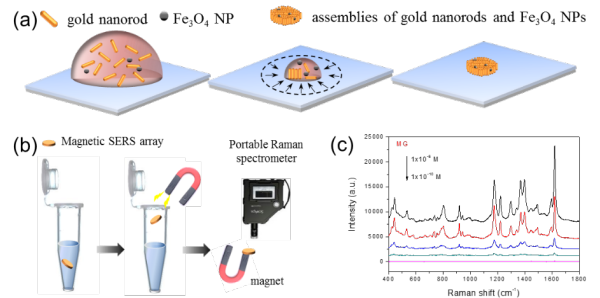A magnetically controllable and removable SERS chip for detection of environmental pollutants and food additives
Date:30-08-2017 | 【Print】 【close】
Surface Enhanced Raman Scattering (SERS) is attractive due to its capability to provide a spectroscopic fingerprint of each type molecule, and provide label-free and rapid on-site detection of different analytes. Although ultrasensitive analysis can be carried out with SERS, in practice, some analytes such as environmental pollutants and food additives always exist in the complex samples at low concentrations, they need to be effectively captured by the SERS substrate and separated from the complex external medium.
In order to enhance the reproducibility of SERS substrate and conquer the complex sample preparation from the complex solution, Prof. YU Xuefeng from Shenzhen Institutes of Advanced Technology, Chinese Academy of Sciences, and his collaborators successfully fabricate a magnetically controllable and removable SERS substrate using the evaporative self-assembly technique. A superlattice array of gold nanorods doped with magnetic Fe3O4 nanoparticles, which is obtained by efficient enrichment and self-assembly of the hybrid nanoparticles and used in SERS detection. The removable plasmonic superlattice array with magnetic properties allows the rapid separation of analytes from the solution and yields excellent sensitivity for environmental pollutants and food additives.
This work has been published as “Efficient Enrichment and Self-Assembly of Hybrid Nanoparticles into Removable and Magnetic SERS Substrates for Sensitive Detection of Environmental Pollutants” in ACS Applied Materials & Interfaces (http://pubs.acs.org/doi/abs/10.1021/acsami.6b16141).

(a) Schematic illustration of the preparation of the SERS substrate; (b) Schematic illustration of detection processes with the SERS substrate; (c) SERS detection spectra for different concentrations of malachite green.
Prof. YU’s group has carried out extensive studies on SERS substrate and detection techniques, and achieved breakthroughs in environment pollutants and food additives detection. These research findings can not only realize the large-scale preparation of highly sensitive SERS substrates with low cost, but also push forward the development of rapid optical detection technology.
These works were supported by the National Natural Science Foundations of China, Leading Talents of Guangdong Province Program, and Shenzhen Peacock Program.
Contact:
Prof. Xuefeng Yu
Shenzhen Institutes of Advanced Technology, Chinese Academy of Sciences
Email: xf.yu@siat.ac.cn